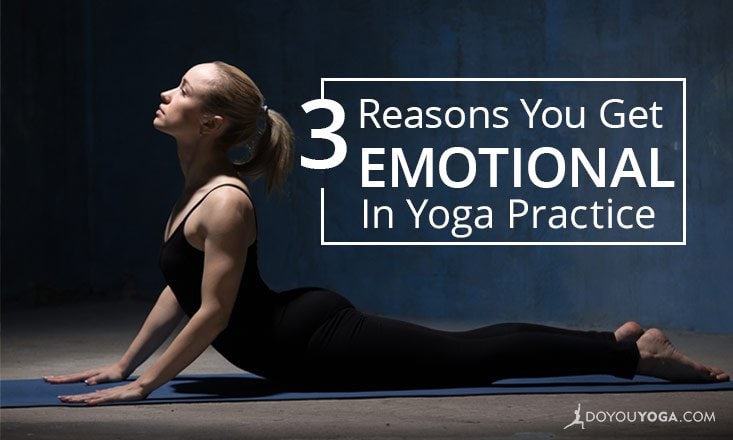As a yoga instructor, I have often witnessed students experiencing what we call an ‘emotional release’ during their yoga practice. Some people find that certain poses on certain days just make them burst into tears, or fill them with an intense frustration about something entirely outside their practice.
Meditation is another way for you to open yourself up to emotion. By allowing your thoughts to come and go effortlessly, you’ll gain focus, even in times of emotional strife. This free 30 Day Meditation Challenge will guide you to a calmer state of mind, so you feel ready for when the emotions hit!
It’s widely known that yoga is not just a physical practice, but few people know that outside of its centering and calming benefits, yoga can also be an intensely emotional journey—and this aspect of a practice can often catch people off-guard.
Curious? Here are 3 important things that science has to say about why you get emotional during yoga.
1. We are starved for connection and touch.
In our ultra-modern world, we can often become distanced from each other physically, blocked from touch and connection by too-busy schedules, technology that plugs us into another reality, and individualistic social norms. Some of us may go days without touching someone else, and this can result in something called ‘touch-starvation’.
Touching other living beings, especially actual skin to skin contact, releases so-called ‘happiness chemicals’ in your brain, such as serotonin and dopamine. That’s why hugging a loved one feels so good, or why you enjoy it when someone plays with your hair.
When we’ve gone too long without that touch fix, we can feel drained, empty, sad, and isolated. If your instructor touches you during practice, this may induce a flood of happiness-inducing chemicals, as well as the sudden realization of how long it’s been since you’ve been touched. This can result in mixed and overwhelming emotions.
Similarly, the judgment-free, communal environment of a yoga class may provide you with a no-stakes way to simply connect with other people, with no words or social anxiety necessary. This feeling of deep, primal connectedness with other human beings can be overpowering as well, and may eventually result in a reassessment of the way we connect with people in our lives.
2. The physical focus helps bring to surface your subconscious emotions.
While yoga can be a physically intense activity, the poses and asanas of a practice can bring your brain into a deeply focused, neutral state. This helps you process anything that is bothering you subconsciously, but that you’ve been unable or unwilling to access directly.
You’re in yoga class: your breath and concentration have helped you relax and calm your mind, wiping away any of the immediate stress and worry. Your present preoccupations are swept away and the superficial level of your brain is now on the back burner, focused on the physical challenges of the practice.
Your deeper mind now has the opportunity to process issues that you’ve been holding below the surface of your immediate consciousness, whether that is stress or anger or intense sadness—or maybe a confusing mix of many things.
In an interview with Yoga Journal, Joan Shivarpita Harrigan (Ph.D. and psychologist) said, “Anytime you work with the body, you are also working with the mind and the energy system—which is the bridge between body and mind.”
Yoga gives your mind a way to process the feelings we bury and push aside. This results in the confusion you experience when suddenly overwhelmed by emotion on the mat, and it can take anywhere from moments to days to search through yourself and consciously pinpoint the original source of the emotion.
But all this introspection is well worth the effort. It can result in a discovery about something that you’ve desperately needed to address.
3. Your body is physically holding on to emotional tension and pain.
For centuries, some cultures have held strong beliefs that mind, body, and what you might call a ‘soul’ are intrinsically linked, and one cannot treat an ailment in one without addressing all three.
This holistic view of healing holds that our bodies remember and store everything that has happened to us in our lives, from trauma to intense joy. When we physically reinvigorate the parts of the body that hold these emotions, as can happen during yoga, we also release those feelings.
For example, stretching and opening the hips and back can release stress and anxiety in many people, which is a good thing when that anxiety is mild. The physical stress leaves the body and is gently processed through breath and focus. If the anxiety is very strong, however, it can overwhelm the person holding the pose, and deeper inward focus and healing are required.
Through yoga’s physical opening of your body’s muscles, tissues, and organs, deep-seated fears and sadness can be brought to the surface. Acknowledgement of the root cause of these feelings can then be addressed mentally, emotionally, and physically.
I encourage everyone who may have experienced emotional release during a yoga class to view it as a gift, and try not to be afraid of what it has to offer. It may not feel like it at the time, but thinking about what poses make you cry and which make you laugh out loud with sudden joy is a real opportunity to explore what you’re storing in which parts of your body.
Maybe you can even try to push deeper and examine what may be the deep-seated root of these yoga-induced feelings. Take your time and see: could your body be telling you something important about what your mind needs?


